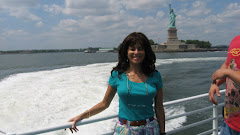


















On the last day of our 13-day cruise, we took an all day private excursion with 1) a 5-hour drive with stunning coastal scenary along both the majestic Sorrento Peninsula and the famous rugged Amalfi Coast AND 2) a 2-hour tour of the ruins of Pompeii with a local university scholar.
Sorrento, Positano, and Amalfi-A Picture Postcard Comes to LifeFrom the port in the gulf of Naples, we began our journey with a southward drive along the coast nestled between sea, sky, cliffs, and lush green groves of lemons, oranges, and olives. With stunning views at every corner, our eyes feasted on the world-famous Sorrento peninsula with its dramatic mountains, picturesque fishing villages and ancient Roman cities. We made a stop in
Sorrento, a popular resort town since the 1700s. Legend tells us it was from Sorrento that the sirens attempted to lure Ulysses onto the rocks. Our group (of 8) headed directly to a friendly café, in Tasso Square, known for its ginormous cappuccinos (only 1.5 Euros), mouth-watering pastries, and clean bathrooms. With free time to explore, we strolled along the shop-lined medieval streets, ever welcoming year-round tourists, many of whom return again and again. I understand why.
We continued our drive along a The
Amalfi Coast, via a rugged road that twists and turns amidst high rugged cliffs and low hills and valleys, overlooking the turquoise and emerald bay. Dotted with ancient villas dedicated to leisure and lush orange and lemon trees, olive groves and vineyards, the views simply take your breath away.
Sidebar: it actually almost did take some of our breathe away. This drive is not for the faint of stomach.Our next stop was the steep-stepped and picturesque town of
Positano, a town with narrow pedestrian streets that cling to tall cliffs. Until we reached the pedestrian-only areas, we strolled on foot while sharing the roads with automobiles navigating the winding roads. (I felt a bit anxious!) We encountered narrow-stepped alleys, pastel-colored houses with vaulted roofs, terraces and tiny gardens, and shops carrying a variety of colorful resort and beach where, pottery, and a wide variety of products made from the regions fragrant lemons. Here, I feasted on a mozzarella and tomato sandwich on herbed focaccia, from a friendly café.
We continued our drive down to
Amalfi, a former 11th-century maritime republic, nestled between mountains and sea. Once again, we enjoyed its scenic beauty and original architecture while visiting shops that cater to its year-round tourists. Local lemon products abound.
From 1:30- till 2:30, we drove inland to Pompeii. Instead of seeing blue waters, our surroundings here were lush emerald green lemon trees, olive groves, and vineyards. Although beautiful, the drive was so upsetting to my stomach that I had to keep my head lowered to stabilize my insides.
Pompeii-one of the most important archeological sites in EuropeOur tour guide, who lives at the university, was passionate, thorough, witty, and allowed us to gain access to sections of the archeological site that are off-limits to the general public. I had heard that Pompeii is not as impressive a site as Ephesus. Boy, were the wrong! Words cannot describe how impressive these remains are of a city buried by an erupting Mt Vesuvius in 79AD-remains of which were first discovered around 1750. The site revealed remnants of a diverse and cosmopolitan city with richly decorated villas, paved streets, public forums, furnishings, brothels, gardens, wine cellars, temples, a 5000-seat amphitheatre, gymnasiums, merchant shops, craftsmen stalls, indoor plumbing, aqueducts, and even an intact toilet. Paintings, friezes, mosaics, sculptures, and commercial signs are seen throughout. Most impressive are the plaster casts that recreate the bodies of victims killed by the volcano’s toxic fumes while engaged in everyday tasks.
Of note, Mt Vesuvius dominates the backdrop of Naples and its entire environs. I even took photos of Mt Vesuvius from my balcony room on the ship.
What a splendid day of discovery, beauty, and gastronomical delight!PS Our driver played famous Italian songs like "That's Amore", as we drove along the Amalfi Coast. It reinforced our great mood.
PPS we paid less than $120 for our full day private tour (8 tourists) (lunch was on our own) while RCL charged $345 for the same itinerary (minus stop in Amalfi) for a larger busload of people. We hired a university scholar on Pompeii (100 euros for 2 hour tour). They used headsets and had guides whose English was challenging to understand and they were “dragged” to a “cameo factory”.































































.jpg)
.jpg)



